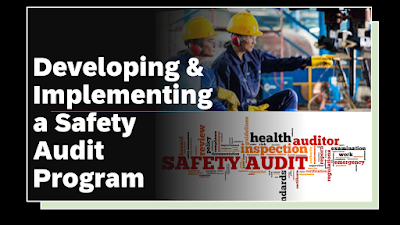Developing and Implementing a Safety Audit Program: A Comprehensive Guide
Developing and Implementing a Safety Audit Program: A Comprehensive Guide
For any organization, a safety audit program is a critical
aspect of ensuring the safety and wellbeing of employees, customers, and
visitors. A safety audit program is a systematic approach that involves
evaluating the organization's safety policies, procedures, and processes to
identify potential hazards and risks that could lead to injuries or accidents.
This will make a safer workplace and improves morale of the employees &
will increase the production. Developing and implementing a safety audit
program is crucial for any organization that wants to comply with local
governmental and international safety regulations and reduce the likelihood of
accidents and injuries in the workplace. In this article, we'll provide a
comprehensive guide on developing and implementing a safety audit program. The
PDCA – Plan Do Check Act is the basic of any safety audit program.
Step 1: Determine Your Objectives
The first step in developing a safety audit program is to determine your objectives. You need to define the purpose of the safety audit program, what you want to achieve, and what areas of the organization you want to focus on. The previous incidents and the lagging indicators, advancement in the health safety & environment may be considered. Your objectives could include identifying and addressing safety hazards, reducing the likelihood of accidents and injuries, ensuring compliance with safety regulations, and improving the safety culture of the organization.
Step 2: Establish a Safety Audit Team
Once you have determined your objectives, the next step is
to establish a safety audit team. The safety audit team should be composed of expert
individuals with a strong understanding of safety regulations, policies, and
procedures. The safety audit team should comprise of the cross functional
expert like the member from production, HSE, shop floor, purchase, human
resource, maintenance execution for the effective audit. The team should also
have expertise in identifying potential hazards and risks and have experience
in conducting safety audits. The safety audit team should be given adequate
resources and authority to conduct safety audits effectively.
Step 3: Develop a Safety Audit Checklist
The safety audit team should develop a safety audit checklist that outlines the safety policies, procedures, and processes or practices that will be evaluated during the safety audit. The safety audit checklist should be comprehensive and cover all areas of shop floor and the departments of the organization production, HSE, purchase, human resource, maintenance execution. The checklist should also be tailored to the specific needs of the organization, considering the industry, the size of the organization, and the nature of the operations.
Step 4: Conduct Safety Audits
Once the safety audit team has developed a safety audit
checklist, they can begin conducting safety audits in a regular interval.
Safety audits should be conducted regularly to ensure that the organization is
complying with safety regulations and that potential hazards and risks are
being identified and necessary control measures are taken to mitigate the identified
the hazard. During the safety audit, the safety audit team should evaluate the
organization's safety policies, procedures, and processes to identify potential
hazards and risks. The safety audit team should also assess the effectiveness
of existing safety controls and identify areas where improvements can be made.
Operation Safety for Lifting Appliances
Step 5: Analyze Results and Take Action
After conducting safety audits, the safety audit team should analyze the observations and take action to address any identified hazards and risks. The identified observations to be made actions with the responsibility & target timeline for the action to be taken. The safety audit team should prioritize the identified hazards and risks based on their severity and take immediate action to address high-risk hazards. The hierarchy of controls for the identified hazards to be implemented for the effective control and to reduce the incidents. The safety audit team should also develop a plan of action to address lower risk hazards and implement improvements to existing safety controls to reduce the likelihood of accidents and injuries. The safety audit team should also suggest the industry best practices followed in the specific type of industries to minimize or eliminate the same type of risks in the industry.
Step 6: Monitor and Evaluate
The final step in developing and implementing a safety audit program is to monitor and evaluate its effectiveness. The periodic review with the progress status still the closure of all the identified observations to be done the leadership management to be done. The safety audit team should monitor the implementation of the plan of action and evaluate the effectiveness of the safety audit program regularly. The safety audit program should be reviewed and updated regularly to ensure that it remains relevant and effective in addressing the organization's safety needs.
Process Safety Incidents - Case Studies
Conclusion
Developing and implementing a safety audit program is
critical for any organization that wants to ensure the safety and wellbeing of
its employees, customers, and visitors. By following the six steps outlined in
this article, organizations can develop and implement a comprehensive safety
audit program that helps identify potential hazards and risks and reduces the
likelihood of accidents and injuries in the workplace. Additionally, having a
safety audit program in place can help organizations comply with safety
regulations and improve the safety culture of the organization.
Occupational Health and Safety Management:
Use of Explosives & Safety Measures

No comments:
Post a Comment